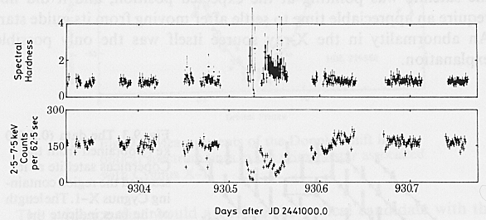Cygnus X-1 light curve (counts and spectral hardness)Cygnus X-1 is one of the best black hole candidates amongst massive X-ray binaries. An artist's conception of this source is available. This figure shows the lightcurve and spectral hardness of Cygnus X-1 on September 4, 1973 as collected by the Copernicus satellite. During the dip at 930.5 - 930.6, we see the spectral hardness increase relative to the quiescent state. The increased spectral hardness is most likely due to absorption of softer X-rays by some intervening matter. In Cyg X-1, these dips usually occur at superior conjunction, the point where the large companion star passes more or less between us and the accreting black hole. The soft component of the spectrum might be associated with an accretion disk corona, while the hard component comes from the inner regions of the disk near the compact object. During the dips, some clumps or blobs of matter in the stellar wind of the supergiant or the outer area of the disk block, absorb or scatter some of the softer X-rays, causing an overall hardening of the spectrum.
IMAGES |
By Mission |
Stars |
HEASARC Home | Observatories | Archive | Calibration | Software | Tools | Students/Teachers/Public Last modified: Thursday, 26-Jun-2003 13:48:45 EDT HEASARC Staff Scientist Position - Applications are now being accepted for a Staff Scientist with significant experience and interest in the technical aspects of astrophysics research, to work in the High Energy Astrophysics Science Archive Research Center (HEASARC) at NASA Goddard Space Flight Center (GSFC) in Greenbelt, MD. Refer to the AAS Job register for full details. |


